The following information on the revolver grip comes from Section 6 of Shooting by J. Henry FitzGerald. Shooting is also available to purchase in print.
Many and varied are the ways in which shooters grip a revolver. The following are some of the most popular revolver grips for a target and quick-draw shooting.
In many clubs and police departments I have found men who, when shooting, squeeze or tighten the entire hand when pulling the trigger. I believe this is a disadvantage and tends to pull the sights out of line with the target. One should not take a death grip on the revolver; it will only cause the hand to tremble and a wild shot will be the result.
The position of the thumb above the latch is very important. In laying the thumb along the top of the frame above latch avoid pressing downward as the shot is fired. This may easily be done in trying to avoid pressing thumb against side of hammer. Allow two-thirds of thumb to rest against the side of the frame and balance of thumb on corner of frame and above. The part of the thumb above the frame will assist in blocking flip of arm after the shot is fired, and will bring the sights into line quickly. A variation of three to five inches will occur at twenty-five yards from different degrees of thumb pressure.
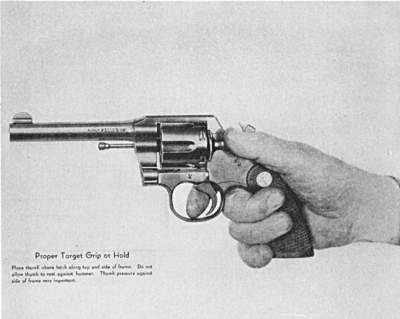
The frame should be pressed between thumb and opposite part of forefinger near third joint, as in the jaws of a pair of pliers, that is, an even pressure on both sides of the frame, and the entire arm grasped tightly enough to keep the sights in line while pulling the trigger. This position is good for both slow and timed fire, for in timed fire the thumb above latch is in the most convenient place to cock the hammer quickly, and is also in the proper place to overcome (by pressure) the tendency to pull to the left in rapid fire and slow fire work. Many shooters who have trouble with the hand slipping up on the revolver grip as the shot is fired will benefit their scores by placing the thumb in this position.
Shooters with a hand like a “ham” (as Colonel Dooley would say) find that the little finger is dangling in space, therefore they lock it across the butt of the revolver. Sometimes this is a material help, especially in rapid fire work, as it holds the revolver against slipping down through the hand when the explosion occurs.
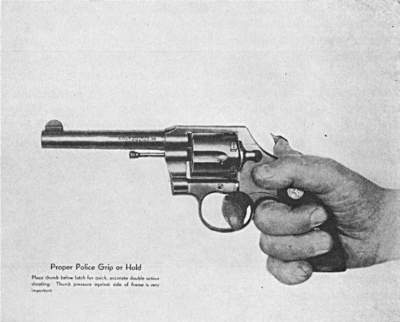
At Camp Perry in 1927 there was heard some high-class arguments on built-up revolver grips, consisting of filling in the top of the space between the trigger guard and the front strap of the revolver. Personally I like the grip of the Official Police revolver just as it comes from the factory and, while I am a past-master as far as fool notions about a hand gun are concerned, I have never tried to improve the grip on this arm. When the controversy was at its height Sergeant Young and his Portland Police and several others, entered in the matches, took off the attachments and I could not find where the scores suffered in the consequence, therefore I am still of the opinion that just as good scores can be made with the arms as issued.
I have heard the many virtues of this addition or, as the shooters call it, gadget, made from dental wax, plastic wood, steel, aluminum and brass, and fitted for each individual need. Like many other so-called helps to perfect scores it must be tried and accepted or rejected like the skeleton hammer, the extremely light pull, and the very narrow sights. If the scores are better than the average stick to them until something better is found. The sooner the shooter settles upon one thing and makes no changes the better the scores.
This was proved at Perry in 1928. Just before the matches the ruling was made that police departments could use the Officer’s Model with adjustable sights or the arm with stationary sights. Many departments immediately changed from the Official Police to the Officer’s Model and found to their surprise that the scores did not immediately jump eight or ten points and some did not shoot as well as before. This was not due to the fact that the Officer’s Model was not as accurate as the Official Police, because it is; the reason was that the men had practiced and become thoroughly familiar with the Official Police both as to action (worn in by use) and height of sights above the frame.
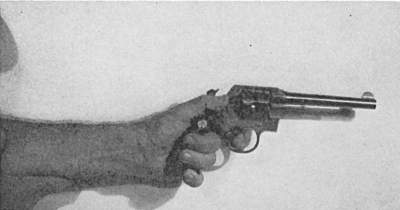
If time for sufficient practice with a new revolver had been allowed I can assure you that the Officer’s Model would not have suffered by comparison. In favor of the Officer’s Model would be the fact that sights may be adjusted to correct for the slightest variation in any direction, which is not easy with solid sights. Also different width of sights may be tried on the Officer’s Model until the desired combination is found. Mid-range and special loads may be used by correcting sights. With the Official Police, sights cannot be easily changed and no sight allowance can be made for mid-range or special loads, but the accuracy of the arms is equal, grip and balance are the same, if barrel length is equal.
Shooting a revolver five shots in ten seconds and five shots in twenty seconds opens up a new field of practice. The proper cocking of the arm (and many months can be consumed by this alone for every fraction of a second saved will benefit the score) is very essential. Several years ago the tendency was to throw the revolver sidewise to allow a better leverage for the thumb in cocking and this will give very good results; many of our best shots still use it. I believe, however, that a split second may be saved by holding the arm in line, drawing the palm of the hand and thumb where they join away from the back strap of the revolver, and cocking the hammer straight back holding the grip with the three lower fingers. The little finger may or may not be locked across the bottom of the revolver grip. Then, by practice, the proper amount of pressure may be brought to bear on the arm so that the arm will be carried only a few inches out of line as the recoil occurs.
Care must be taken in the ten and twenty second work to start properly, place the first shot and keep track of the time. There is plenty of time but none to waste. Sometimes in the ten and twenty second work the shots will group to right or left while the arm shoots center for slow fire. The remedy for this is to hold over enough to center the shots, as the change of group is caused by a slight flinch or yank of the trigger or insufficient thumb pressure.
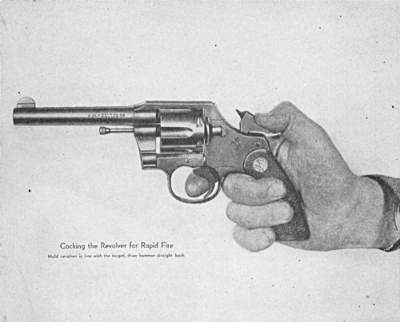
Another fine revolver grip is with the thumb below the latch. This position is especially adapted to quick draw and double-action shooting and is also a perfect revolver grip for target shooting.
A checked wood revolver grip is best for all kinds of shooting for with a rough check no slippage in the hand should occur, but whatever grip you prefer will give you good results if you grip the arm the same way every time.
I have tried several of the foreign pistols for grip and balance and I am still in favor of the American revolver grip. I still believe that we make the best revolver, automatic pistols, and single shot pistols here in the United States, and set triggers, reclining couches for the thumb, wrist braces and other appliances of like nature have no place on a he-man’s revolver or pistol.
The same belief must be entertained by the rest of the clan, as I seldom see a foreign pistol or revolver in competition. It is true that matches are won with the Tell and other pistols of foreign make, but it is usually in matches where one or two days are consumed to fire fifty shots. American shooters are keyed up to the fifty shots in one hour at fifty yards and it is torture to them to enter a match allowing twenty-four to forty-eight hours for fifty shots.
If any addition or subtraction from the present American revolver grips will help the individual shooter with a hand above or below normal size, I do not blame him for using it. The object in target shooting is to finish with the best possible score. Revolver grips, as furnished, may seem strange to the beginner, but constant practice will accustom the hand to the grip and a comfortable grip or hold will be the result.
Before leaving this subject of the revolver grip, let us go more thoroughly into the matter. Many times I have been told that placing the little finger under the grip will change the position of the group on the target. It will if the shooter has a small hand, for crossing the little finger will tend to change the position of entire hand to a point lower down on the grip away from the center of bore.
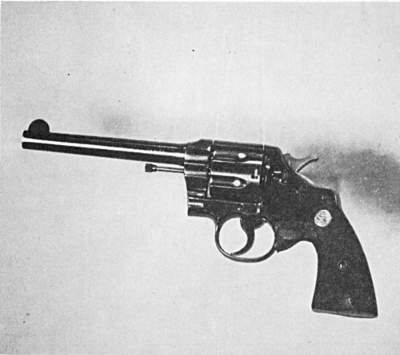
If the shooter possesses a large hand, one that fills the grip to the extent that the little finger is taking up space to bottom of the grip, then that man could easily cross the little finger on bottom of grip without changing sights for correction of group unless he exerted undue pressure with the little finger.
The little finger across the butt is of great assistance in rapid-fire shooting if the size of the hand permits such a hold. It assists in checking the upward motion of the revolver and prevents it from slipping downward through the hand due to recoil. It assists through leverage in cocking the arm.
A revolver may be fired with the little finger under the grip or with the little finger on front strap, with thumb above latch or with thumb below latch, without changing sights or position of group if care is taken to distribute hand pressure evenly at all points.
